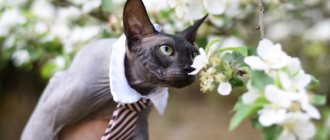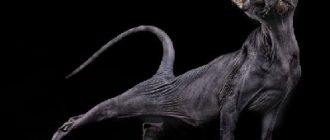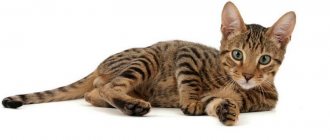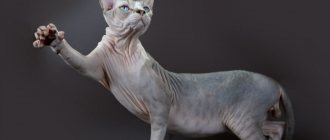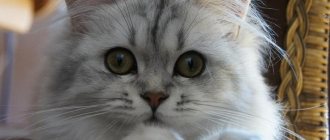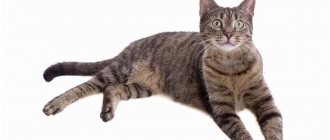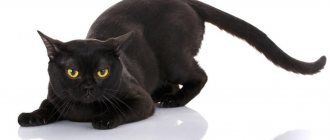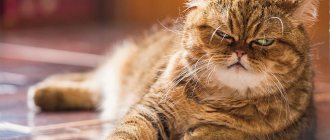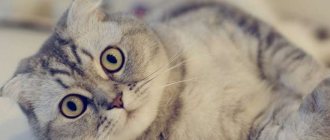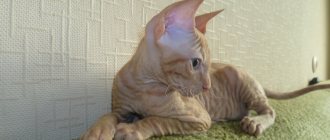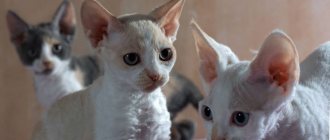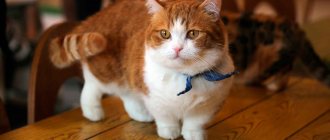Despite their atypical appearance for felines, sphinxes continue to win our hearts, becoming more and more popular among cat lovers every year. However, hairless cats continue to be quite rare due to the limited gene pool.
Why the Sphynx cat is still a curiosity, where hairless cats come from, what kittens from a Sphynx and an ordinary cat will be like, as well as many other features of the breed varieties will be covered in this article.
Varieties of Sphynxes - breeds with photos and names
If you still think that the Sphynx is one breed, then this article is for you. Officially, felinological associations recognize three varieties of hairless cats. We will talk about them in this article.
Note! There are also breeds of hairless cats that are not recognized by felinological associations. For example, the Bambino (a cross between the Sphynx and the Munchkin) and the Ukrainian Levkoy.
Canadian Sphynx (moon cat)
Canadian hairless cats have become the standard among other branches of hairless cat breeds. The founder of the breed in 1975 was a completely hairless kitten born from a short-haired mother.
A little later, his hairless sister was added to the first one, born a year after the significant birth of the most famous hairless cat. The naked babies were bought by the Z. Stardust nursery, the first hairless kittens became the founders of the most elite branch of the breed, their descendants are distinguished by their impeccable exterior and unparalleled “velor” skin.
Don Sphynx
Donchak is a much younger breed than Canadians. Don or Rostov hairless cats are a domestic breed, bred in Rostov-on-Don, recognized much later than their hairless overseas relatives from Canada. As an independent breed, Rostov Sfin cats received recognition in 1980.
Peterbald (Petersburg Sphynx)
One of the youngest branches of the Sfin cat breed is considered to be a breed bred in St. Petersburg. A new branch was created by crossing an Oriental cat and a Donetsk Sphynx in 2003.
Sphynx temperament
Sphinxes are naturally endowed with intelligence and good memory. Among the representatives of the breed there are the most intelligent cats that are easy to train and can be taught various tricks. These animals are incredibly smart, but they require some training to develop their natural qualities. The hairless Sphynx cat, whose breed description indicates natural curiosity, needs constant monitoring. A cat should not be left unattended outside for long periods of time as it could end up in a potentially dangerous situation.
Domestic Sphynx cats often show activity and a lively character. They do not refuse entertainment, toys, cat exercise equipment, so during the absence of the owner they can amuse themselves on their own. The lively antics of Sphynxes often become a source of headaches for owners who do not know how to curb their pet’s temperament and wean it from climbing cabinets and playing with curtains.
By nature, sphinxes are the most unusual cats with a contradictory disposition. They, like dogs, can spend hours in trembling excitement at the door, waiting for the owner to return home. Cats do not hide their joy and emotions when they see their owner after a long separation. At the same time, the Sphynx cat does not show special affection for other pets and children and behaves coldly and reservedly towards them.
Because of this, breeders do not often offer families with growing children to buy a Sphynx cat, the price of which is about $1,000 for a “show” class pet. Married couples with children are advised to pay attention to more affectionate and patient pets, such as Scots or Raigdolls. Read about Scottish cats in the article “The Scottish cat is an animal with a gentle temperament and a loyal character.”
Features of cats without hair
According to legends, the Egyptian Sphynx cat escorted the souls of the inhabitants of Ancient Egypt to the afterlife. According to legends, among the Aztecs, unusual hairless cats with large ears evoked reverence and respect. Allegedly, Aztec cats lived at temples, and the Aztecs revered hairless cats with large ears as divine beings.
The owners of modern Sfin cats jokingly prefer to classify their pets as alien creatures. Some owners simply say that sphinxes are magical cats. By the way, it’s hard to disagree with this statement. Everyone has long known the healing abilities of cats: cats find a sore spot on their owner, diligently knead it, massage it, and then lie down on the source of pain to warm it with their natural warmth. So, among Sfin purrs, these abilities of home healers are doubled due to the contact of the hot skin of a hairless cat with human skin.
Cats without fur need to be fed more often than their furry relatives. To maintain the necessary thermal balance of the body, the Sfin cat requires more frequent feeding and much more food than a purring cat with fur.
Sphynx body temperature
As for small hairless kittens, the normal temperature for them is 38.5-39.5⁰C. Metabolism in babies is higher, metabolic processes occur faster than in adult animals, therefore the normal body temperature in kittens is higher than in mature individuals.
In adult hairless cats and hairless cats, the normal body temperature is 38-39⁰C.
Do sphinxes have mustaches?
Many sphinxes either have no whiskers at all, or they are broken off or curled. In some Sphynx cats the whiskers fall out and grow back. Moreover, the process of loss and regrowth of whiskers in Sfin cats is a very individual matter, not amenable to any predictions.
In the language of zoologists, cat whiskers are called vibrissae; for purrs, this simple-looking device works both as protection from external dangers and as a means of navigation.
Cats are nocturnal animals and love to hunt in the dark. To recreate a complete picture of the environment, the cat uses sensitive antennae, with which it is able to detect air currents and vibrations.
If a cat's whisker touches any object, the purr will immediately trigger a defensive reaction - the cat will reflexively close its eyes. What if the obstacle touched by the vibrissa turns out to be a sharp branch, wire or some other dangerous object? Nature took care of the soft-footed meowing hunters, providing them with an additional organ of touch in the form of sensitive vibrissae.
Any Sphynx cat, although a representative of the cat family, is not a night hunter. A hairless cat is unable to survive either in the wild or on the street: it is an exclusively decorative creature bred to be kept at home. Such a pampered, whimsical animal does not particularly need a hunting attribute in the form of sensitive long whiskers.
Sphinx tail
The tail of a healthy animal should be flexible and mobile, thick at the base, gradually tapering towards the tip. Sphinxes often curl their sensitive whip-like tail into a ring, which adds even more mystery and piquancy to their unusual appearance. At the tip of the tail, sphinxes are allowed a “lion tassel” - a small tuft of hair.
Unfortunately, this part of the body in hairless cats can be problematic and bring a lot of inconvenience to the pet and its owner.
- Problem one: Anomalies, deformations and other defects of the tail, both congenital and acquired. A Sphynx of any breed that has an underdeveloped, deformed or broken tail will not be allowed for breeding. But that’s not so bad – not all pets can be the stars of a show. The trouble with congenital tail deformation is that a “broken” tail may turn out to be the tip of the iceberg, under which many diseases are hidden that threaten the health and even the life of the animal.
- Problem two: Angular cystic acne, acne, comedones. Both young animals during puberty and mature animals actively involved in breeding are susceptible to these unpleasant skin diseases.
The first of these misfortunes disfigures the cat's tail; angular cystic acne results in persistent scars that are almost impossible to remove with any absorbable ointments.
On the affected areas of the skin, cystic cavities filled with pus are formed; the inflamed foci can merge with each other and open out through the fistula tracts. The disease lasts a long time; a shell of keratinized skin particles and exudate forms on the inflamed areas.
Acne and comedones are more often observed in hairless (rubber) cats. To prevent acne, hairless animals are bathed in a decoction of chamomile or string. Also, do not forget to regularly wipe your pet’s tail with a special degreaser.
Do Sphynxes have fur?
Yes, there are.
According to the breed standard, only the Canadian Sphynx does not have varieties with fur. The animal's skin should have only minimal invisible fluff. There is short pubescence on the muzzle.
But domestic cats - the Peterbald and the Don Sphynx - according to the breed standard, allow individuals with different types of hair. We will talk about them in detail in the next section.
Did you know that a hairless cat can give birth to a fluffy kitten? In some individuals it falls out over time, while others remain fluffy.
Types of Sphynxes with fur
These types apply only to St. Petersburg and Don sphinxes:
- Brush . The coat of the Brush species can be either hard or soft and silky to the touch. The length of the hair is 2-3 mm. The coat can be straight and wavy, or crimped and hard, reminiscent of an old brush that has served its purpose.
- Flock . The skin of a flock animal is covered with tiny short hairs, reminiscent to the touch of a peach skin. As a rule, flock cats walk “in clothes” made of peach fluffs until they are 1.5-2 years old, then they completely “undress”.
- Velor . If you touch a velor seal, you are left with the feeling of touching velor or thin, very high-quality suede. The length of the hair is 2-3 mm. The fibers of velor individuals are much more noticeable than the tiny flock, barely visible to the human eye.
Why are sphinxes bald?
Genetics played a major role in the development of hairless cat breeds. Sphynxes are cats without hair, bald, cute mutants with an unusual appearance caused by the hairlessness gene. This mutation gene has long been tested by felinologists for stability, however, a hybrid of a Sfin cat and an ordinary cat is not always born bald.
Canadian Sphynx owner reviews
“We got a cat with the habits of a dog! He recognized me as the hostess; my relationship with my husband was cool. He responds to his nickname, jumps on his shoulder on command, and greets him from work. Calmly tolerates hygiene procedures - bathing, ear cleaning. There is no fur in the apartment, and for me the Canadian Sphynx is the best breed in the world. The only thing is that it smells a lot when going to the toilet, and often. Don’t even try to save on filler.”
“Perhaps our Kasia is not a purebred Canadian, since she was taken without documents. But it looks amazing - like an elegant Egyptian figurine. Constantly meows and talks. And she’s ready to eat all the time, voracious like an elephant. Climb onto the shoulder, head, chest. In this case, in the heat of the moment, he may begin to climb his bare leg. He loves to sit on my laptop - it’s warm, and on the stove! I can't wean it off. She carries toys in her teeth and is very smart. Tender, affectionate, not earthly"
“Bucks are with me everywhere, I’ve come to terms with it. It doesn’t matter what I do - cook, wash, wash the floor - he wants to help me or at least watch. She sleeps on the bed and bothers my husband and me. Walking across the face or biting the leg is normal for him. It’s a shame to kick out the bald guy, he’s like a child. In general, at night the devil wakes up in it, jumps on the furniture, turns the whole house upside down. We love, we forgive"
“My Canadian is a fiend. No, he is not aggressive, quite the opposite. Always climbs into your arms, wants to be petted and kissed. But my life revolves around a cat, if I describe all his pranks, I’d get a whole book. He rides on curtains and breaks furniture, ignoring the scratching post. Tears off the wallpaper. He pulls clothes off the dryer. Destroys toilet paper. Flushes the toilet because it's fun. Yes, he taught himself to use the button! Steals food. He throws everything off the shelves and off the table. At first I cried and wanted to return Benny to the breeder. Then I got used to it. Life is boring without him! I’ll go kiss your warm bald belly.”
“We have a girl, Cleopatra, of the Canadian Sphynx breed. I warn everyone that sphinxes are not cats, they are children. They need to be taken care of, they need to be loved. If you don’t have time for a pet, don’t torture yourself or the animal - choose another breed.”
How does a Sphynx get along with other cats?
Hairless cats and cats get along well in pairs with individuals of their own species. Touchingly hugging their paws, they love to cuddle, lick each other and show mutual care in every possible way.
Sphynxes have a friendly character, so they do not get into trouble with other pets and do not arrange for division of territory. The only thing that a bald cat cannot share with another cat is the love of its owner. Sfin cats require more attention to themselves than other pets.
“Master, have as many cats as you want, but love only me!” - this is the motto of the naked cat.
Character
Sphinx personality traits:
- Sociability - pets are very attached to the owner, preferring to sleep in their arms or under a blanket on the bed. Cats always greet their owner, they are touchy, but they don’t hold a grudge for a long time. Sometimes a pet's behavior can be overly annoying.
- Playful is an active animal, often getting into mischief at a young age. Due to the lack of fur, sphinxes are not recommended to be taken outside, so it is important to pay enough attention to your pet. In its absence, the cat becomes lethargic and apathetic. They easily find a common language with children.
- Intelligence - Sphynxes quickly get used to the tray and are easy to train. They can be taught to fetch toys, lie down, or stand up on command.
- Lack of aggression - if a cat doesn’t like something, the animal will prefer to hide rather than start scratching or biting.
The St. Petersburg and Canadian Sphynxes are considered the most “talkative,” while the Don variety of cats is considered the most silent. Like other types of cats, sphinxes are characterized by a love of boxes, excessive curiosity and a wary attitude at first towards new people or other animals.
How much does a hairless cat cost - price in Russia
Only three breeds of hairless cats are officially recognized by feline dog associations:
- Canadian Sphynx. The price of a kitten, depending on the class and elite status of the parents, varies from 8 to 100 thousand rubles.
- Don Sphynx. The price of a kitten varies from 9,000 rubles to 30,000 rubles.
- Peterbald. The cost varies from 5 to 25 thousand rubles.
There are also unrecognized breeds of hairless cats, for example, the Ukrainian Levkoy or the Bambino. However, despite the “unrecognition”, you won’t be able to buy a hairless cat on the cheap. Bambino will cost an average of 20-50 thousand rubles, and Ukrainian Levkoy - 10-20 thousand rubles.
Health and life expectancy
Sphinxes have a strong immune system, but there are also a number of diseases that are inherited:
- Myopathy – weak neck muscles; during life, the entire muscular system may weaken.
- Heart failure.
- Airway obstruction.
Such diseases appear at an early age, and the breeder must notify them in advance.
Sphinxes are also prone to the following diseases:
- turning of the eyelids;
- vasculitis – reddish or bluish dots appear on the skin;
- acne – appears due to strong production of subcutaneous sebum;
- conjunctivitis;
- dermatitis.
If properly maintained, the average lifespan of a Sphynx is 14–17 years.
Pros and cons of sphinxes
Positive aspects include the high intelligence and docile nature of hairless cats, their affection and devotion to their owners - it’s not for nothing that sphinxes are called “kissing” cats.
Some breed lovers consider the negative aspects of keeping sphinxes to be their increased love for tactile contact. Occasionally this “alien miracle” shows excessive intrusiveness; not all people will like a cat’s butt sitting on their own face. By placing his hot butt on the owner’s head, or even on the owner’s “face,” the naked cat believes that in this way he will express his boundless love much more clearly. And you will have to come to terms with this - the cat is a “kisser”...
Description of the breed
All Sphynx cats have developed muscles and delicate skin. The head has large ears that resemble locators, and the eyes have a slight slant. All sphinxes have a high body temperature, this is a feature of the animal’s heat exchange; in this case, it is not necessary to contact a veterinarian. The average height of a cat is 30-40 cm at the withers, and its weight is about 5 kg. There are general standards that the entire Sphynx breed has. They also apply to all representatives of hairless cats.
You can read about the Burmese cat breed and its colors here.
Appearance and standards
There are basic features of the Sphynx breed, approved by international organizations, which breeders and nurseries involved in breeding these cat breeds must adhere to. The characteristic features of the sphinxes are:
- The head is of medium size, in the shape of a rounded wedge, the length should be greater than the width. The forehead should be flat, with a smooth transition between the bridge of the nose and the forehead. The muzzle itself is short with high cheekbones and clearly defined boundaries. The chin should be strong, creating a perpendicular line with the upper lip. The whisker pads are well defined, but the whiskers themselves (vibris) may be completely absent.
- Ears. They are the main objects of attention. They are large in size compared to the head. They are erect and open, with a wide base. The inside should have no fur at all.
- Eyes. Large, almond or lemon shaped. They have a narrowing on both sides, planted far apart. The color of the iris can be any, but must be in harmony with the overall color.
- The animal's neck is of medium length and has the shape of an arc with developed muscles.
- Body. It is of medium length with a developed wide chest, round in shape. The belly is also rounded. The back of the animal is rounded.
- The legs are of medium length and should be in proportion to the rest of the body. In this case, the hind legs are slightly longer than the front ones. The paws are oval in shape and have long toes on all limbs.
- The length of the tail corresponds to the general proportions of the body, with characteristic flexibility and grace, gradually tapering towards the end.
It is by these criteria that one can determine the purebredness of the breed, as well as determine the quality of the pedigree.
Canadian Sphynxes.
Coat and colors
The Sphynx's skin is thicker than that of other cats and has numerous folds. There are especially many of them on the face and paws. Outwardly, the animal looks completely bald, but in fact there is a small fluff on the skin, several millimeters long. The fur may be on the outside of the ears, between the toes, and on the scrotum. There is a classification of Sphynx fur, dividing it into different types:
Naked. Such animals are already born naked and are considered the most expensive and rare; they are highly valued by breeders. There is homozygous and undressed. The latter have an inconspicuous fluff that quickly disappears.- Flock. This coat is soft to the touch, very short and almost invisible. Sometimes it can disappear completely.
- Velours. This type of cover can be felt when you touch it, but the cat appears naked. To understand that a cat has a covering, you need to stroke it. Once a year the animal sheds. There are three types of velor - light, velor-point, down.
- Brush. The animal is born with dense, curly hair, the whiskers are curled. There are three types of brushes - brush velor, point, dense.
- Straight-haired. Such an animal has the fur of an ordinary cat, but the physique and character of a sphinx.
The Sphynx can be any color. These are all types of colors that are found in all cat breeds - solid, tortoiseshell, tabby and others.
What types of sphinxes are there?
Sphynxes can be very different; there are varieties of Sphynx breeds (Canadian, Don, Peterbald and others), according to the cover and structure of the coat (nude, flock, velor, brush, straight-haired).
Table of the main differences between the varieties of the Sphynx breed.
Based on this classification developed by felinologists, it becomes clear about the condition of the animal’s fur. Hairless animals are considered the most valuable individuals among breeders and breed lovers. The cost of such kittens is higher than that of others.
Naked Sphinx.
Flock.
Velours.
Brush.
Straight-haired Sphynx.
Is it true that there are no allergies to hairless cats?
This is one of the most common misconceptions associated with these animals. Many are sure that Sphynx cats do not cause allergies. In fact, allergies to Sphynx dogs exist. Firstly, Sphynx cats have fur that also sheds, causing problems for allergy sufferers. Secondly, this reaction is caused by the skin secretion that these animals secrete. This breed has an increased ability to do this.
The history of the origin of the breed - how hairless cats appeared
The first Don Sphynxes appeared from a half-haired cat of unknown origin, which was found in a trash heap by a kind-hearted Rostov woman. The woman tortured the found half-sphynx with procedures aimed at restoring the fur until she came to terms with the fact that no medicines or ointments help return the coveted fur to the found purr. In the end, the pussy was left alone, and later she brought hairless kittens from an ordinary short-haired cat, which became the founders of the breed of the first domestic sphinxes.
A similar story happened in Canada, when a hairless mutant kitten was accidentally discovered on a farm. “Rostovite” and “Canadian” are two opposite branches that have different genotypes; these two types of sphinxes do not cross with each other.
There are persistent rumors among felinologists that the first hairless cats could have appeared much earlier than the relatively new breed of hairless cats - the Canadian Sphynx cat. Strange cats without hair were noticed by the British at the beginning of the last century, but then there were difficult times in England, people were not interested in breeding “mutants with an alien appearance.”
Rules of care and maintenance
Recommendations for caring for sphinxes:
- Pets do not have eyelashes, so the cornea is more often washed with tears mixed with dust. Because of this, brownish discharge appears in the corners of the eyes, which should be removed with a piece of gauze or a cotton pad soaked in chilled black tea.
- Sphynxes are characterized by excessive secretion of skin lubricant and secretions in the ears. The ears should be carefully treated with a cleansing lotion, and then remove dirt with a cotton pad. You should not penetrate deep into the sink so as not to impair your pet’s hearing.
- It is recommended to bathe the cat at least once a month, otherwise skin discharge will remain on everything the animal touches. In addition, a peculiar odor will begin to emanate from his body. Washing is carried out with animal shampoo - human cleansing compositions are not suitable for use, as they lead to a violation of the pH of the skin. If an excess of brownish plaque with an unpleasant odor appears on the skin, you need to visit a veterinarian - most often, the problem lies in an unbalanced diet.
- The claws are trimmed with a nail clipper several times a month - in sphinxes they grow back quite quickly. During a manicure, you need to carefully remove any secretions that have accumulated in the nail bed with a damp cloth or cotton wool.
Due to the lack of fur, cats easily become hypothermic, so the owner must always monitor the temperature in the house and buy the pet a house and special clothing in advance.
The Sphynx can stay in the sun for a short time - this will give its skin a golden hue. But prolonged sunbathing will cause burns.
Interesting facts about Sphynx cats
- A naked cat is a “kissing” cat! The owner of a loving Sphynx should come to terms with this fact, because a hairless pet constantly requires communication and tactile contact. Sfin cats love to lick the hands of their owners - this is how they show their love.
- Sfin cats are extremely jealous. No, they are not at all against other pets. It's just that hairless cats want their owner to love the Sphynx more than other pets.
- Hairless cats love to cuddle.
- In addition to the well-known types of breed varieties (Canadian, Donskoy, Peterbald), there are several interesting varieties of hairless cats - Bambino, Ukrainian Levkoy, Elf, Dwelf, Cojona, Minskin.
- What kind of kittens will be born if you cross a Sphynx with an ordinary cat? Mixed half-sphinxes will be attractive in appearance, but they are unlikely to fully meet the breed standard - in this case, outbred genes will not add advantages to the animal’s exterior. However, kittens born from a half-sphinx will be carriers of the hairless gene.
Cost and principles of choice when buying kittens
The cost is affected by the presence of defects such as:
- underdeveloped muscles;
- small ears;
- muzzle is too long or too narrow;
- the presence of fur in some areas of the body, more than 3 mm.
The price for each Sphynx kitten is set individually by the breeder - first of all, it depends on the pedigree and the opportunity to take part in exhibitions in the future. Buying such a pet will cost on average $600–1000. The cat is sold together with a passport, vaccination certificates and pedigree.
If you have no plans for exhibition activities, you can find a baby for 100–300 dollars - these animals have some external defects that do not meet the standards.
Photo
Price of Don Sphynx kittens. Where to buy a Don Sphynx cat. Don Sphynx nurseries
Unlike some recently emerging cat breeds that are just achieving world fame, Don Sphynx cats became popular almost immediately. Both in Europe and the USA, and in the CIS countries, many nurseries offer to buy wonderful Don Sphynx kittens that meet the standard and all the expectations of future owners.
The price of Don Sphynx kitten ranges from nine to thirty thousand rubles.
The cost depends on various factors, including the reputation of the nursery.
If you take Don Sphynx kittens from breeders, the most reasonable price in this case is about ten thousand rubles.
Don Sphynx nurseries:
- MY TOYS;
- Ramses.
